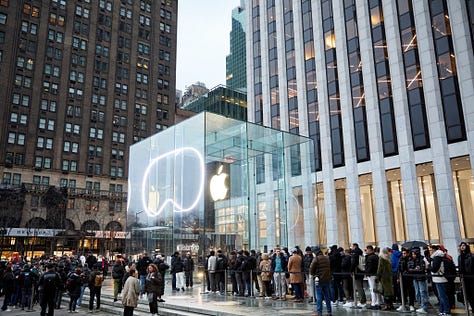Repurposing the need for skeuomorphic design in the age of Spatial Computing
Congratulations to the Apple Vision Pro team
Bridging the Digital and Physical Through Design
As we venture deeper into the age of spatial computing, a domain where our physical and digital worlds coalesce, the role of skeuomorphic design is experiencing a renaissance. This design approach, which replicates real-world textures and objects in digital interfaces, is not just a relic of the past but a key tool in shaping future technologies.




Skeuomorphism: A Familiar Guide in Unfamiliar Territories
In spatial computing, people interact with digital environments that are seamlessly integrated into their physical surroundings. Here, skeuomorphic design serves as a familiar guide, offering intuitive visual cues that ease the transition from traditional 2D interfaces to immersive 3D spaces. This approach, remains relevant as it helps demystify the complexities of spatial computing, making technology more accessible and people-friendly.
The Evolution of Design in Spatial Computing
The leap from designing for screens to creating for spatial computing environments requires a thoughtful evolution of skeuomorphic principles. It's no longer about imitating physical textures on a flat display but about reconstructing the tactile experience in a three-dimensional context. For instance, a digital interface in spatial computing could simulate the texture and weight of real-world objects, offering users a more tangible and interactive experience.
Functionality Meets Familiarity
In spatial computing, the challenge lies in harmonizing the novelty of 3D spaces with the comfort of known interactions. This balance is crucial for applications that integrate digital elements into real-world settings. By employing skeuomorphic design, we can provide users with familiar experiences in an entirely new context, thereby enhancing both functionality and user engagement.
Apple Vision Pro demo by @iamjesserichard breathes new life into the value of Album cover art:
People-Centric Design in Three Dimensions
At the heart of repurposing skeuomorphic design for spatial computing is the focus on human experience. The transition from flat design to spatial design necessitates a deep understanding of how people perceive and interact within a 3D space. The aim is to craft familiar environments that are not only visually compelling but also naturally easy to navigate, drawing on the principles of familiarity and functionality.









Conclusion and congrats
As spatial computing reshapes our interaction with technology and the rest of the world waits in line, the principles of skeuomorphic design, honed during Apple's most innovative years, gain new significance. This design philosophy, with its emphasis on familiarity and functionality, is pivotal in creating spatial computing experiences that are both revolutionary and relatable.
Dear Apple Vision Pro team,
I want to extend my deepest congratulations to each and every one of you on the Vision Pro team. Your dedication, creativity, and hard work have not gone unnoticed.
The journey of innovation and design is a challenging yet rewarding one. Your achievements reflect that same spirit of pushing boundaries and crafting experiences that resonate with people.
Remember, every line of code, every element of design, and every late night has contributed to something larger than just a product; you've helped shape how people interact with technology. Your work continues the legacy of excellence that we strived for while the company was in good care during Apple’s Golden Era.
Once again, congratulations on your remarkable work. Here's to many more successes and to continuing the tradition of excellence at Apple.
Best regards,
Michael Darius
Instructions on how to access my design services:
Things I started, enjoy and can help with...
The best way to transform a company’s product line from the inside out is to lock 5 people in a room for three months and tell them not to come out until they’ve redesigned the company. Things I Started: 💌 Apple Webmail 🎁 Apple’s first gift card experience





